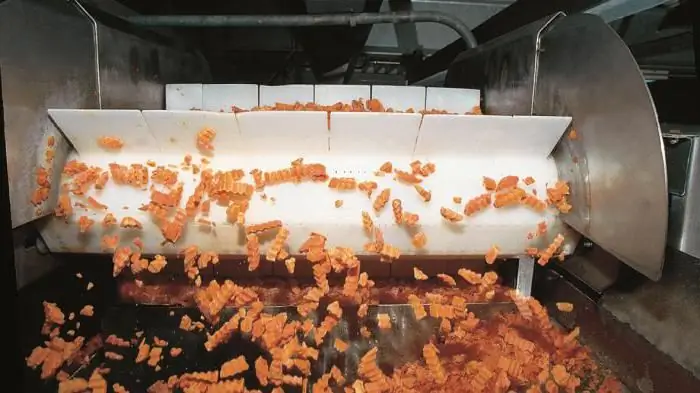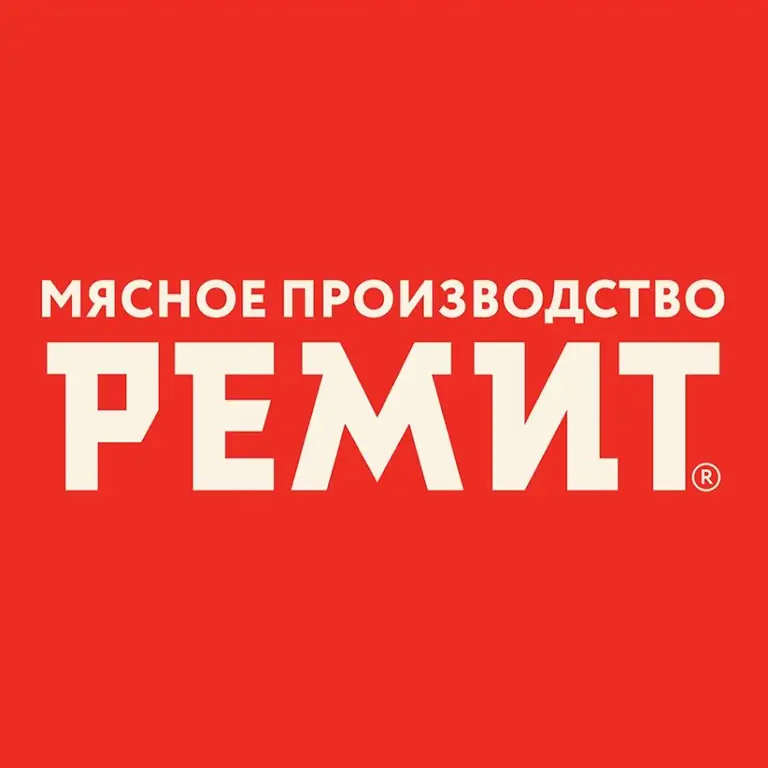2026 Author: Howard Calhoun | [email protected]. Last modified: 2025-01-24 13:10:37
Entrepreneurs involved in the production of sausages or, for example, semi-finished meat products, often face the need to carry out such a procedure as deboning pork. Technologically, this operation is complex. And therefore, in both small and large food industry enterprises, highly qualified experienced specialists are usually responsible for it.
Definition
After slaughter, pig carcasses are bled. This procedure is necessary in order to improve the quality of the meat at the exit. After bleeding, carcasses are usually divided into half carcasses. Then they are sent either to their own meat products processing workshops or sold to other enterprises of this specialization.

Sometimes already cut meat is found in the wholesale market. But such a product is most often unreasonably expensive. Therefore, even small entrepreneurs prefer to purchase still ordinary carcasses and half carcasses and subject them to further processing on their own. This saves on raw materials.
The next operation after bleeding and cutting carcasses intohalf carcasses and is boning. This is the name of the procedure in which the meat is separated from the bones. When performing pork deboning, it is important to strictly observe all the required technologies. Otherwise, the meat yield will decrease significantly, and consequently, the enterprise will incur losses.
Main two varieties
Meat can be processed in this way using two technologies:
- manually;
- mechanical.
The first technique is usually used in small and medium-sized enterprises, for example, specializing in the production of dumplings, pasties, smoked meats, etc. The second technology is used in large meat processing enterprises engaged in the production of sausages, sausages and semi-finished products.
Preparation
When using this technique, the way the meat is separated from the bones may depend on:
- age of animal;
- degrees of his fatness, etc.
At the first stage, half carcasses are divided into parts. The number of the latter depends on the type of farm animal. For example, beef half carcasses are divided into 7 parts, lamb - into two cuts. Pigs are relatively small. Therefore, their half-carcasses are usually divided into 3 parts.

Manual technology
Next, proceed to the actual deboning of pork. The following rules and regulations must be observed when performing this procedure:
- shoulder, shoulder, thigh and pelvic parts of the carcass are separated in such a way as not to violate the integrity of the muscle mass of the meat;
- the lumbar and dorsal-costal part is cut off, respecting the boundaries of the longissimus muscle, subscapularis, hem and brisket;
- the back-costal part is either cut off in a layer with its subsequent separation, or semi-finished products are directly isolated.
The pork is deboned carefully, trying not to damage the muscle tissue. According to the regulations, after this procedure, the meat should not have cuts deeper than 10 mm.
Hand Deboning Example: Back Cut
Each specific part of the carcass must be processed in compliance with certain technologies. For example, the back of a pork cut is rolled as follows:
- put the ham on the table with the subcutaneous side down, the pelvic bone towards you;
- meat is cut from the inside of the pelvic bone;
- meat is cut off the ischium by moving the knife away from you;
- meat is cut from the outside of the pelvic bone in the direction from the pubic fusion to the ilium;
- take the pelvic bone with the left hand and cut the tendons between it and the femur.
All these operations are performed by moving the knife in the direction first away from you and then towards you.

Next:
- make an incision from the underside of the pubischium and clean the meat from the ilium;
- the pelvic part is taken by the pubischial fusion, and holding the meat with the right hand, the bone is removed with a jerk with the left;
- the right side of the back cut is turned with the tibia towards you and the meat is cut off from its left side;
- separate the meat from the right and left sides of the fibula;
- separate the tibia from the femur;
- meat is cut from the left and then from the right side of the femur;
- put the femur upright and completely separate the meat from it.
On the left side, first cut off the meat from the ilium and separate it from the pubic ischium. Then the tendons are divided between the femur and pelvic bones. Next, cut the meat from the underside of the pubic-sciatic part. The pelvic bone is removed with a jerk and then the deboning is performed in the same way as on the right side.
Tools
Pork is deboned at enterprises using knives, most often made of carbon steel with the addition of vanadium, molybdenum, chromium. These tools are durable and strong. Only knives with a hardness of at least 57 HRC are considered suitable for deboning.

The handles of such tools must also be durable and comfortable for workers. In Russia, enterprises most often use boning knives with wooden handles. Such a tool allows you to perform the operation with the highest quality. Wooden handles do not slip when wet. In addition, these knives have a good balance. However, in some countries the use of tools with such handles for deboning is prohibited. This is explained by the fact that with such knives it is difficult to clean the area in the area where the blade adjoins the tree, as well as rivets. As a result, these places canstart harmful microorganisms.
Mechanical deboning in large plants
Manual technology of deboning pork meat is usually used if the meat is intended for making minced meat for sale or, for example, for making dumplings. In the production of sausages, half carcasses are processed using a different, simpler technology. Minced meat, since it includes more veins, in this case turns out to be of less quality, but labor costs when using this technique are low.
In such factories, the meat is separated from the bones either on a conveyor belt or by several specialists at once. Pork deboning technologies can be used as follows:
- differentiated - each specific part is assigned to one deboner;
- differentiated vertical - the carcass moves slowly over the conveyor in a suspended state and is subjected to stage-by-stage processing by deboners;
- combined - used on carcass parts that are difficult to process and allows up to 50% of meat to be left on the bones.
Also, enterprises can sometimes use conventional manual processing on the table by the efforts of one specialist. This method in this case is called carcass deboning.

What equipment is used
When deboning pork, a finished product is obtained containing a certain amount of bones and veins. Minced meat from meat processed in this way can have a different quality. In this case, everything depends both on the qualification of the deboners and on the type ofequipment.
At large enterprises, special automatic conveyor lines are used for deboning, including pork. Their use allows you to optimize production as much as possible. Also, when using them, losses during deboning of pork are reduced.
From the sides on the frame of such conveyors, removable tabletops are fixed, which are the workplaces of the personnel. The speed of the main conveyor belt for such equipment is adjustable. Above the main conveyor, an additional one is usually installed for skins, bones and sinews. To collect the latter, a special bunker with a plastic assembly container is intended. After filling the latter, they simply take it out and send the bones for processing into flour, which is then used as a food additive in raising farm animals.
A part of such lines is usually, among other things, a system of automated accounting for the distribution and cutting of raw materials, to which scales are connected at three technological points:
- for incoming raw materials;
- bones and waste;
- meat after cutting.

Pork deboning: meat yield
There should be practically no meat left on the bones after processing. The output of this product depends primarily on the qualifications and skills of the deboner. In large enterprises, this indicator is determined by standards. Yield rates for meat and offal for beef and pork are shown in the table below.
| Product name/output | Beef (%) | Pork (%) |
| Meat | 73, 6-70.5 | 71.6-62.8 |
| Bones | 22.2-25.1 | 13.4-11.6 |
| Shpik | - | 13.6-24.4 |
| Cartilage and tendons | 3.2-3.4 | 0.6-0.4 |
| Losses | 1 | 0.8 |
The yield of meat when deboning pork from different parts of the half carcass can, of course, be different. Certain standards, of course, must be observed in this case. They are also indicated in special tables.
Of course, due to differences in the composition of meat on different parts of half-carcasses, the pulp at the outlet after deboning is of unequal quality. This is one of the features of the procedure. For example, when deboning the shoulder blades, brisket and back, more low-grade meats are obtained than when processing other parts. In this case, the output is a lot of veins and cartilage.
Zhilovka
This procedure is carried out at enterprises after mechanical deboning of pork or manual deboning. When it is performed, coarse connective and adipose tissue is released from meat - veins, cartilage, small bones, large blood vessels, blood clots. Also, lymph nodes are removed from the pulp.
During trimming, among other things, such a procedure as the final sorting is performedpork. When performing this operation, the following rules are observed:
- meat is cut into separate muscle groups;
- cut the muscles in the longitudinal direction into pieces weighing no more than 1 kg (for raw smoked sausages - 400 g);
- separate connective tissue from pieces of meat.

In large enterprises, veneer workers, as in deboning, usually specialize in different parts of the carcass.
Recommended:
How to transfer money from Russia to Germany: payment systems, rating, transfer conditions, exchange rates and interest rates

The Russian market, as well as the system of international money transfers, has changed markedly over the past decade. Most banks provide a range of services related to sending foreign currency abroad. Domestic systems of fast money transfers are significantly expanding the geography of their presence. This is only beneficial. Money transfer to Germany is also available
Classification of tax rates. Types of tax rates

The rates for different types of taxes can be classified in a variety of ways. What are the relevant techniques that have become widespread in Russia? How can the current taxes in the Russian Federation be classified?
Meat: processing. Equipment for meat and poultry processing. Production, storage and processing of meat

Information of state statistics show that the volume of meat, milk and poultry consumed by the population has significantly decreased in recent years. This is caused not only by the pricing policy of manufacturers, but also by the banal shortage of these products, the required volumes of which simply do not have time to produce. But meat, the processing of which is an extremely profitable business, is very important for human he alth
Meat fermentation: process, structure and properties of raw meat

Gourmets know that a good steak is not easy to cook. And in this matter, everything is important - the choice of meat, its preparation (autolysis or fermentation of meat), the degree of roasting. Despite the great popularity of home grills, the secret to cooking a good steak remains a mystery to many. In the article we will talk about the difference between a beef steak from fermented meat and a steak from a steam room. And also about how to ensure the fermentation of raw materials at home
REMIT Meat Processing Plant LLC: feedback from customers and employees, manufactured products and quality of meat products

REMIT reviews are of interest to customers who are considering options for cooperation with this company, and employees who expect to get a well-paid and stable job. In this article, we will talk about this meat processing plant, what products it produces, whether its quality corresponds to the declared one, what its employees and partners say about the enterprise

